Dating recent sediments from the subaqueous Yangtze Delta and adjacent continental shelf, China
Zhang-Hua Wang , Yong-Hong Dong, Jing Chen Xiao-Feng Li, Juan Cao,Zhi-Yong Deng
1.State Key Laboratory of Estuarine and Coastal Research, East China Normal University, Shanghai 200062, China
2.Department of Geography, East China Normal University, Shanghai 200062, China
3.Shanghai Radiation Environmental Supervision Station, Shanghai 200065, China
1 lntroduction*
Sediment deposition at river mouths and on continental shelves provides a record of changes in land-sea interactions controlled by climate, sea level, human activity,ecology, and other environmental factors in both terrestrial drainage and marine basins, and therefore attracts the attention of researchers worldwide.Chronology is always one of the most important but difficult aspects of the reconstruction of sediment successions.Since the first application of210Pb geochronology for marine sediments(Koideet al., 1972), the fallout radionuclides, mostly210Pb and137Cs, have been used widely for dating recent river mouth and shelf sediments.But there are obvious limitations on the use of these geochronological methods.Previous research revealed that210Pb and137Cs are enriched in fine-grained sediments (Chantonet al., 1983; Cundy and Croudace, 1995)and organic matter (Wanet al., 2005)because of their higher cation exchange capacities compared to coarse quartz particles.Particle mixing (bioturbation, resuspension), which is a dominant process in river mouths and on the shelves, also causes uniform210Pb activity profiles in the uppermost layer of cores in many stud-ies and thus spurious interruptions to the successions (De-Masteret al., 1985; Lewiset al., 2002; Weiet al., 2007).Furthermore, Kirchner and Ehlers (1998)demonstrated that denudation of137Cs from the Chernobyl accident in the surface sediments of coastal deposits in the island of Sylt (Germany)could not be identified from a210Pbexdepth profile.Therefore, they suggested that any geochronology solely based on210Pb would be seriously misleading and the combined use of both radiotracers is necessary for establishing reliable geochronologies in coastal environments.Smith (2001)also suggested that210Pb geochronology must be validated using at least one independent tracer, such as fallout137Cs, that separately provides an unambiguous time-stratigraphic horizon.However,137Cs does not work in some places, as described, for example,by Ruiz-Fernández and Hillaire-Marcel (2009)from shallow coastal environments in the Pacific coast of Mexico.They demonstrated the lack of137Cs signals for210Pb corroboration in addition to the limitations of210Pb for reliable historical reconstructions.Therefore, other non-radiological time markers, like sediment lithology, are important for the geochronology of recent coastal sediments (Kirchner,2011).In the study of sedimentation rates of the subaqueous Yangtze Delta (Weiet al., 2007), more than half of the excess210Pb profiles demonstrate uniform or disordered patterns and discrepancies are always obvious for sedimentation rates obtained from the210Pb and137Cs methods.Although they used a Digital Elevation Model (DEM)method based on navigation charts of different years to estimate sedimentation rates of the delta front and slope, an unambiguous chronology is still unable to be obtained for a sediment core by the DEM method.
Spheroidal carbonaceous particles (SCPs), which have no natural sources and are only formed from the high temperature incomplete combustion of fossil-fuels such as coal and oil, are recognized as unambiguous indicators of atmospheric deposition from power generation and other industrial sources (Renberg and Wik, 1985).No apparent degradation and post-depositional change of SCPs has been found in lake sediments (Rose and Appleby, 2005).SCPs are thus used to provide reliable chronologies for recent lake sediments because they can be easily and efficiently extracted from sediments (Rose, 2001)and can be unequivocally identified with microscopy due to their distinct morphology (Roseet al., 1995; Rose and Appleby,2005).The use of this non-radiological time marker has become widespread in recent years including for dating coastal sediments (Vaalgamaa and Korhola, 2004; Marshallet al., 2007).
The high temperature combustion of fossil fuels is closely related to regional economic development, so that SCP (spheroidal carbonaceous particle)deposition profiles also have regional characteristics.Once the SCP record from a region is established using accurately dated cores,SCP profiles can be used to determine dates of other cores in the region that lack good210Pb and137Cs geochronologies (Roseet al., 1995; Boyleet al., 1999).SCPs have been used to date lake sediments in the Yangtze drainage basin and delta plain in studies by Boyleet al.(1999),Roseet al.(2004), and Wuet al.(2005)(Figure 1a), who have provided similar SCP profiles of the middle and lower Yangtze Basin.However, there has been no SCP profile produced for the sediments off the Yangtze coast, where it has proved difficult to cross-validate chronologies using210Pb and137Cs dating methods.
In this paper we examine lithology and SCP distributions in addition to the fallout radionuclides in two short sediment cores, YZE and CX38 (Figure 1b), from the subaqueous Yangtze Delta and adjacent continental shelf.We determine the geochronology of the two cores and discuss the advantages and limitations of different dating methods.The results demonstrate that the lithological change associated with the evolution of the North Channel and ages inferred from SCP profiles are important to validate the210Pb and137Cs geochronologies.
2 Regional setting
The Yangtze River splits into two branches at its mouth and the South Branch further splits into the North and South Channels (Figure 1b).Freshwater has flowed mainly through the South Branch since the 18thcentury and the North Branch gradually silted up (Chenet al.,1985).Since the late 1950s, little freshwater has been discharged through the North Branch and tidal currents have predominated there.The North Channel of the South Branch was formed by several big floods during the mid-19thcentury and since then the main current of the Yangtze freshwater flow has frequently migrated between the North and South Channels, leading to periodic erosion and siltation of these channels and offshore areas.When the major freshwater current flows through the North Channel,erosion occurs there and deposition of coarser sediments dominates offshore from the North Channel.For example,obvious accretion was observed off the North Channel during 1978-1985 when the North Channel developed and discharged the majority of the Yangtze freshwater (Chenet al., 1999).In contrast, siltation dominated in the SouthChannel and only fine-grained sediments were deposited offshore of the South Channel, supplied by the suspended sediments of the southward outflow from the North Channel (Chenet al., 1985; 1988).The reverse occurs when the major freshwater flow goes through the South Channel.
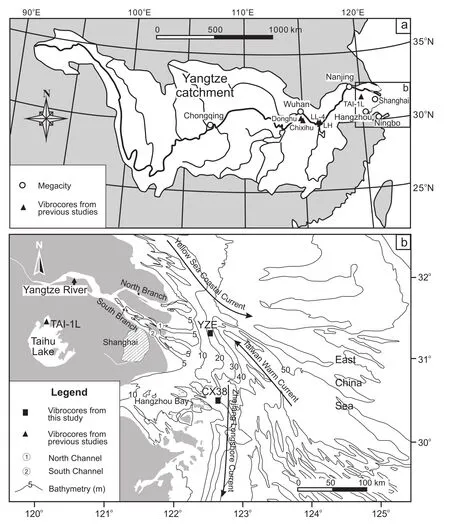
Figure 1 Location of the study area and the short cores.a-The Yangtze catchment showing some megacities in the middle and lower basin and the cores that have been analyzed for SCPs in previous studies (Boyle et al., 1999; Rose et al., 2004; Wu et al., 2005); b-Core locations in the subaqueous Yangtze Delta and adjacent continental shelf.Oceanic currents are also shown.
The subaqueous Yangtze Delta is characterized by several southeast-northwest extending river mouth sand bars outlined by the 5 m isobath, and a southeast oriented tongue-like mud depocenter delineated by the 50 m isobath (Figure 1b).A V-shaped submerged valley is present at the northeastern side of the mud depocenter, where the Taiwan Warm Current intrudes, especially in summer, andimpedes the dispersal of suspended sediment further southeastwards (Beardsleyet al., 1985).Hangzhou Bay lies to the southwest of the subaqueous Yangtze Delta, separated by many small bedrock islands (Figure 1b).The Yellow Sea Coastal Current flows from the north toward the Yangtze River mouth and turns eastward at the north fringe of the subaqueous delta.The Zhejiang Longshore Current, formed mainly by the Yangtze freshwater discharge,flows southwards in a narrow band confined to the coast and transportsc.30% of the suspended sediment from the Yangtze discharge, forming a longshore mud wedge (Millimanet al., 1985).
The middle and lower Yangtze drainage basin is one of the most heavily developed regions of China.There are many megacities with populations ofc.3-20 million particularly in the Yangtze coastal area (e.g., Shanghai,Nanjing and Ningbo; Figure 1).Coal and oil consumption has increased exponentially since 1950 in China and especially in these megacities (Figure 2).The first fossilfuel power generating station was opened in Shanghai on 26 July, 1882.From then until 1911, more thermal power stations were built in several major cities in the Yangtze drainage basin and on the Yangtze coast, including Chongqing, Wuhan, Hangzhou, Shanghai, and Ningbo (Figure 1a).The thermal power output from fossil fuel combustion increased slowly but steadily in Shanghai from 1911 to 1937, and then declined until 1945 (Figure 2).It increased again after 1945 and then speeded up after 1957, with asmall drop around 1962 (Figure 2).

Figure 2 Coal and oil consumption in China, Nanjing, and Shanghai since 1950 (data source: Chinese Statistical Yearbook), the annual thermal power output of Shanghai since 1900 (data source: Shanghai Statistical Yearbook), and the sedimentary SCP record in the lakes of Taihu (TAI-1L)(Rose et al., 2004), Chixihu, Donghu (Boyle et al., 1999), and Longganhu (LH and LL-4)(Wu et al., 2005)in the middle and lower Yangtze catchment.
SCP concentrations in sediments from Taihu Lake on the southern Yangtze delta plain demonstrated a similar development as the coal consumption in Nanjing, and thus were used to date the lake sediments (Figure 2; Roseet al., 2004).The results of TAI-1L by Roseet al.(2004)demonstrate that the start of the SCP record in the Taihu Lake sediments is earlier than 1940, and rapid increases occur from the mid-1950s to the mid-1960s and from the early-1980s to the early-1990s (Figure 2).Other studies of SCP in lake sediments from the middle Yangtze also show an exponential growth in phase with local fossil fuel burning and thermal power output (Figure 2; Boyleet al.,1999; Wuet al., 2005).In these cases the start of the SCP records is in the early-1950s and rapid increases generally occurred from the mid-1950s and early-1980s.
3 Materials and methods
We used a gravity corer and obtained core CX38 in July 2006 at water depth 25.2 m and core YZE in December 2008 at water depth 26.4 m from the subaqueous Yangtze Delta and mud wedge off the Zhejiang coast (Figure 1b;Liuet al., 2006).CX38 and YZE are located at 122.6oE,30.5oN and 122.5oE, 31.3oN and are 2.10 m and 2.38 m long respectively.The sediment cores were kept in the core library at 4 °C immediately after they were taken from the sea.We split the cores, made lithological descriptions and photographed them in the laboratory (Figure 3).Then the core sediments were sampled into slides of 1 cm thick.The outer rims of all slides were trimmed off and then samples were put into plastic bags.105 samples of YZE and 100 samples of CX38 were measured for grain size at an interval of 2 cm by a Beckman Coulter Laser Diffraction Particle Size Analyzer (LS13320).137Cs,210Pb and226Ra measurements were done for 48 samples from YZE at a depth interval of 2-8 cm and 48 samples from the upper 150 cm section of CX38 at a depth interval of 2 cm by Gamma-Spectroscopy Systems (GWL-120-15, ORTEC)in the Nanjing Institute of Geography and Limnology, Chinese Academy of Sciences.The CIC model was applied to calculate the sedimentation rates of the two cores because the top sediments were unavailable due to gravity coring.
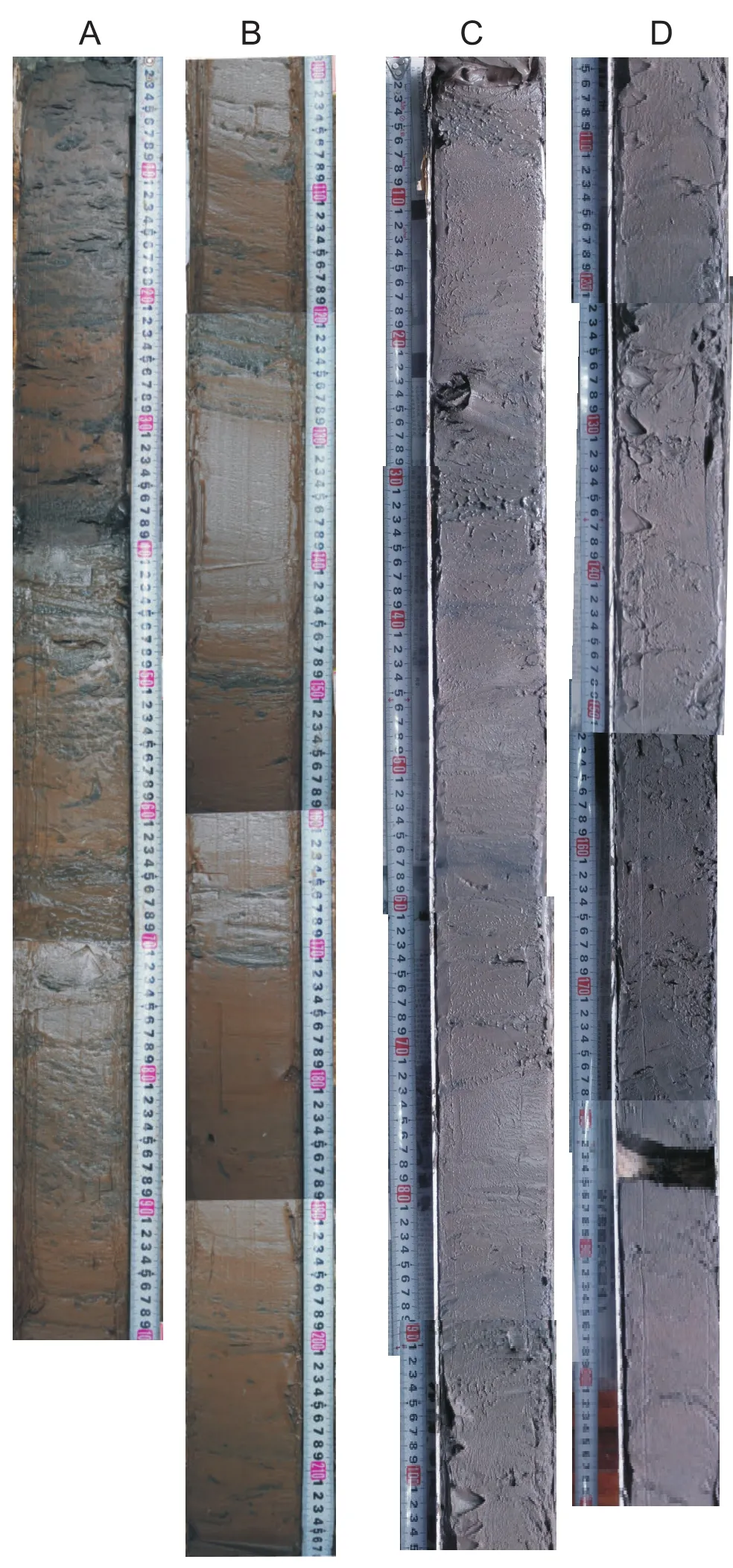
Figure 3 Photos of cores YZE and CX38.A-0-100 cm of YZE; B-100-218 cm of YZE; C-0-105 cm of CX38; D-105-210 cm of CX38.
SCP analysis was performed for 35 samples from YZE and 55 samples from CX38 at intervals of 2-16 cm.Specimen preparation and SCP identification followed the procedure described in detail by Rose (1994; 2008).Each sample was initially mixed and dried at 40 °C.We used ~5 g samples, much larger than those used for the lake sediments, given the higher sedimentation rate of the subaqueous Yangtze Delta (Weiet al., 2007)which could result in relatively low concentrations of SCPs.The sediments were accurately weighed (ranging between 5.0000 g and 5.0748 g)into 100 mL labeled polypropylene tubes.After adding 50 mL HNO3, we added another 30 mL HNO3after 10 hours and heated the tubes in a water-bath at 80 °C for 3 hours.After cooling, the tubes were filled with dis-tilled water and centrifuged at 2800 rpm for 5 minutes.The supernate was then carefully pipetted off.The residue was neutralized by repeating the steps of washing, centrifuging and pipetting.We then added 80 mL HF to each tube and returned the samples to the water bath at 80 °C for 3 hours.After the residue was neutralized as above, we added 80 mL 6M-HCL to each tube and heated the tubes in the water bath at 80 °C for another 3 hours.The residue was washed and centrifuged to neutral again as before and then transferred to an accurately weighed and labeled 10 mL polypropylene tube.The 10 mL tubes with specimen were centrifuged again at 2800 rpm for 5 minutes, and then were weighed after pipetting off the supernate.Known fractions of the final residue were removed and evaporated onto cover slips and were mounted onto microscope slides with Naphrax.One to five cover slips were counted for each sample.Identification of SCPs was done using a light microscope at 400 times magnification and strictly following the criteria of Rose (2008), including features of round shape, black color, three dimensional, porosity, and fragmentation size of >0.5 particle (Figure 4a).Scanning electron microscopy (SEM)was further used for some selected samples to ensure correct particle identification(Figure 4b).Note that only SCPs with a diameter >10 μm were counted because it was too difficult to distinguish them from the impurities.Then the total number of SCPs on each slide was converted to an SCP concentration expressed in terms of the number of SCPs per gram dry mass of sediment (gDM-1).As SCP identification is done particle by particle, the errors involved in counting are relatively low even at low SCP concentrations (Roseet al., 1995).
4 Results
4.1 Lithology and grain size
The lithology of YZE is characterized by yellowish gray clayey silt with abundant sand or silt laminations of a few millimeters to about one centimeter thick at a core depth of 0-100 cm, and yellowish gray homogeneous mud with some silt laminations of 1-5 mm thick at 100-240 cm depth (Figure 3).A gradational contact occurs between the two sections.The clay content is mostly between 30%and 45%, while the sand content is always 0%-8% below 100 cm (Figure 5).Clay decreases to <25% while sand increases into 10%-45% above 100 cm.The mean grain size increases from 6.47-41.92 μm below 100 cm to 14.05-64.92 μm above 100 cm (Figure 5).
Homogeneous gray mud prevails with some silt laminations ofc.0.5 mm thick in CX38 (Figure 3).The clay content is mostly between 30% to 40%, silt is between 55% to 75%, and sand is less than 5% (Figure 5).The mean grain size is from 8.58 μm to 31.33 μm, mostly around 15 μm.
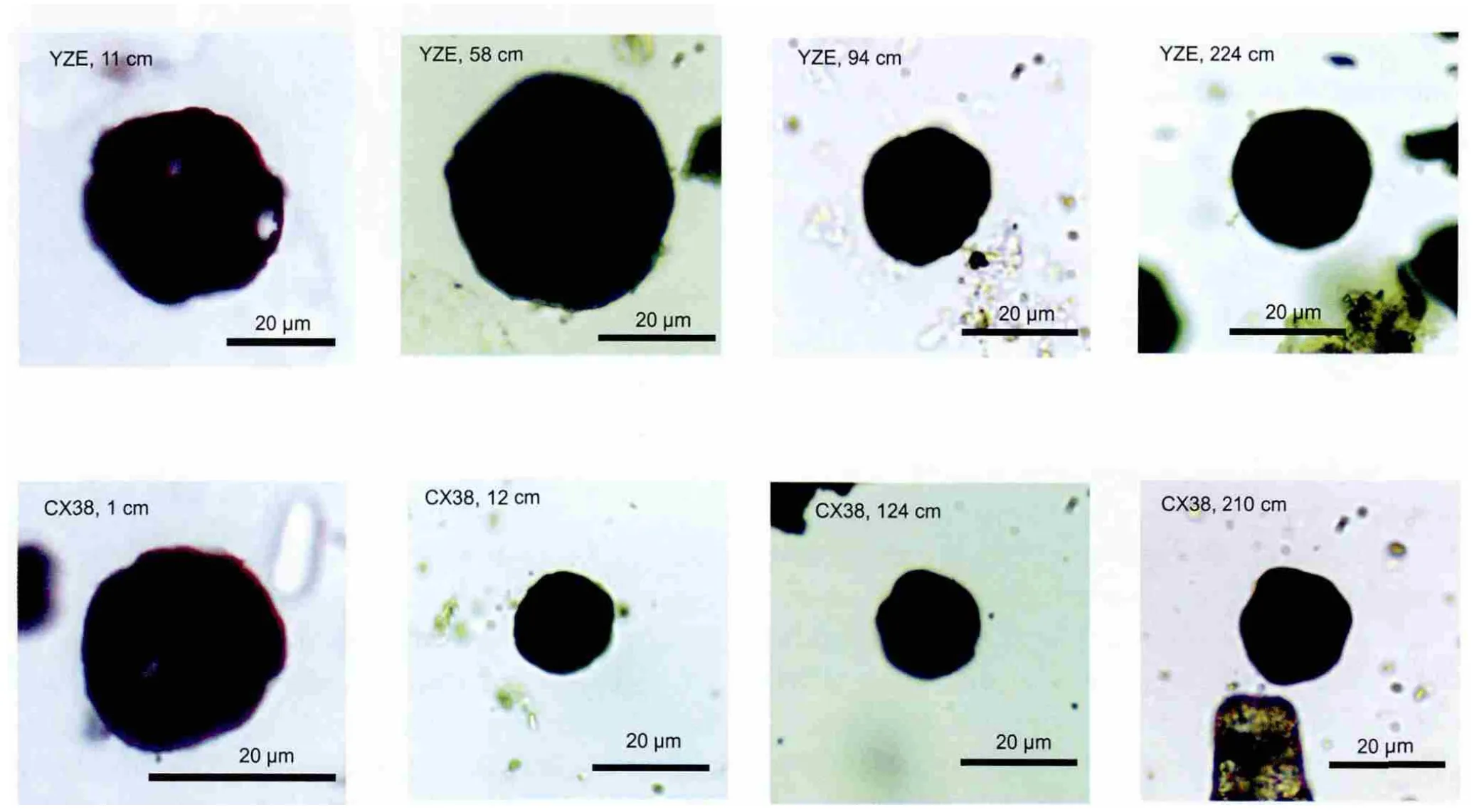
Figure 4a Light microscope images of SCPs extracted from the subaqueous Yangtze Delta and adjacent continental shelf sediments.
4.2 137Cs and 210Pb activities
The137Cs activity is quite low (<3 Bq/kg)in both cores(Figure 5).The first occurrence of137Cs is at a core depth of 104 cm in YZE, being 1.70 Bq/kg.It then declines to zero at 100-90 cm and is detected continuously above 88 cm, with two major peaks (1.78 Bq/kg and 2.52-2.53 Bq/kg)at 80 cm and 42-38 cm.The activity of137Cs is lower in CX38, and is only detected at a depth of 18.5-22.5 cm,48.5-52.5 cm, and 68.5-80.5 cm.Peak values are only 0.5-2.2 Bq/kg.
The total210Pb activity is 53.65-243.41 Bq/kg in YZE,with the peak concentration at 84 cm.Excess210Pb is from 32.41 Bq/kg to 196.01 Bq/kg, with the peak value also at 84 cm (Figure 5).Higher values but disordered profiles of both total and excess210Pb concentrations occur above 85 cm, sharp reductions happen at 85-100 cm, then both concentrations increase again below.Total210Pb varies between 110 Bq/kg and 150 Bq/kg mostly at 116-206 cm without an obvious declining trend with depth.Excess210Pb generally declines with depth below 100 cm except for two extremely low values (c.34 Bq/kg)at 152 cm and 170 cm and one obvious high value (c.116 Bq/kg)at 194 cm.
In CX38, the total210Pb activity decreases distinctly with depth and the excess210Pb activity decreases with a nearexponential pattern (Figure 5).Although there is no near surface flattening or decline, disturbance and flattening occur at 10-90 cm.For example, obviously low values (86 Bq/kg and 71 Bq/kg)of the excess210Pb appear at 20.5 cm and 28.5 cm, while it reaches 142-145 Bq/kg at 75-85 cm.
4.3 SCP distributions
SCP appears throughout both short cores and the start of the SCP record is not reached in either core (Figures 4, 5).But high SCP concentrations only occur in the upper sections and reduce exponentially with depth from the core top to 75-80 cm and then remain low with only weak peaks present at 130 cm in YZE and at 125 cm in CX38
(Figure 5).The SCP concentration in the upper section of YZE is noticeably higher than that in CX38, despite the fact that the sediment grain is much coarser in YZE (Figure 5).There are some remarkably low values occurring during the upward increase in YZE, such as at the depth of 14 cm, 22 cm, and 58 cm.But these declines of the SCP concentration are not in phase with the sediment grain size change (Figure 5).Fluctuations of the SCP concentration also occur in the upper section of CX38, but the amplitude is much lower.
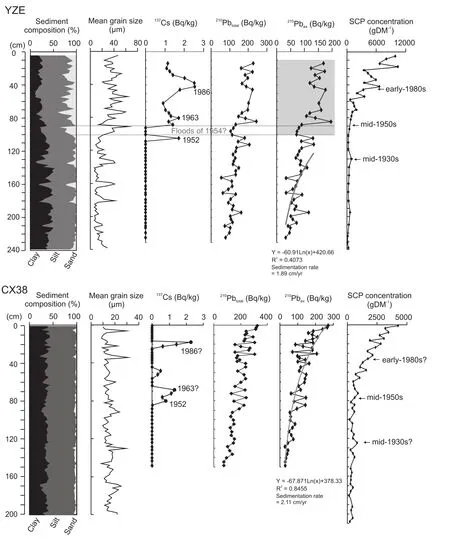
Figure 5 Sediment composition, mean grain size, activities of 137Cs, total and excess 210Pb, and SCP concentrations of YZE and CX38.The mean sedimentation rate is calculated by the CIC model using excess 210Pb data below 100 cm in YZE.The shaded excess 210Pb profile above 100 cm in YZE represents disturbed data.The mean sedimentation rate is also presented by the CIC model using the excess 210Pb profile of CX38.Some absolute ages are indicated by 137Cs and SCP profiles.
5 Discussion
5.1 Chronologies and validation of independent dating methods
5.1.1Absolute ages from YZE by lithological change
We suggest the lithological change of YZE reflects the evolution of the North Channel.It is reported that the North Channel of the river mouth was silted and controlled by flood tidal currents during 1927-1948.Then the big floods in 1949 and 1954 (Changjiang Water Conservancy Commission, 1875-1990)washed out the major sandy shoals which silted the entrance of the North Channel and made it again the main passage of freshwater after 1958 (Chenet al., 1988).This process explains the abrupt decline in137Cs and total and excess210Pb activities at the core depth of 100-90 cm (Figure 5);i.e., the sediments were eroded from the North Channel which carried no137Cs and less210Pb and then were re-deposited offshore during the big flood events in the early- to mid-1950s.Since the restoration of the North Channel as the main waterway for Yangtze discharge after 1958, more suspended sediments were dispersed from the North Channel, resulting in accretion off the channel and the associated coarser sediment succession in the upper section of YZE (Figure 5; Chenet al.,1988).Therefore we assume an absolute age of early- to mid-1950s for the sediments at 100-90 cm depth of YZE(Table 1).
5.1.2Absolute ages determined by137Cs
The lower activities of137Cs in CX38 than in YZE(Figure 5)possibly support previous opinions that the riverine input rather than the atmospheric deposition is the major source of137Cs in the East China Sea (Su and Huh, 2002)and that the sediments in the Zhejiang longshore mud wedge were resuspended and transported from the subaqueous Yangtze Delta during the dry season(Chenet al., 1988).Therefore, we suggest that the ages inferred by137Cs are more reliable in YZE,i.e., the first detection at 104 cm corresponding to the early-1950s and peak values at 80 cm and 40 cm corresponding to the years 1963 and 1986 respectively (Table 1).We use radioactive decay to explain the fact that the 1986 peak is stronger than the 1963 peak (Figure 5).For CX38, the first detection of137Cs at 80.5 cm corresponding to the early-1950s may be still reliable because the137Cs sources were not so complex at that time.
5.1.3Absolute ages determined by SCP profiles
The mid-1950s and the early-1980s were found to be two important times when SCP concentrations started to accelerate in most previous SCP profiles in the lake sediments of the mid-Yangtze Basin and the delta plain (Figure 2; Boyleet al., 1999; Roseet al., 2004; Wuet al., 2005).These two periods correspond to the two important periods of the economic development in China.The mid-1950s is the time when China began to recover from the long period of war and the early-1980s is the time when reform and the policy of opening-up significantly stimulated the economy.These changes are reflected in the rates of coal and oil consumption in China as a whole and specifically in megacities such as Shanghai and Nanjing (Figure 2).We suggest that the above fossil fuel consumption history could also be reflected by the SCP profiles of YZE and CX38 (Figure 5).The mid-1950s can be allocated at a core depth of about 90 cm and the early-1980s at about 45 cm in YZE by mapping the SCP profiles with the history of annual thermal power output of Shanghai (Figures 2, 5; Table 1).There is a weak peak at 130 cm, possibly corresponding to the mid-1930s when economic activity on the Yangtze coast reached a peak before the Second World War.In CX38, the mid-1950s can be allocated at a core depth of about 75 cm and the mid-1930s possibly at 125 cm (Table 1).But the absolute age of early-1980s is difficult to identify (possibly ~35 cm), because there is no obvious change in the accumulation rate (Figure 5).
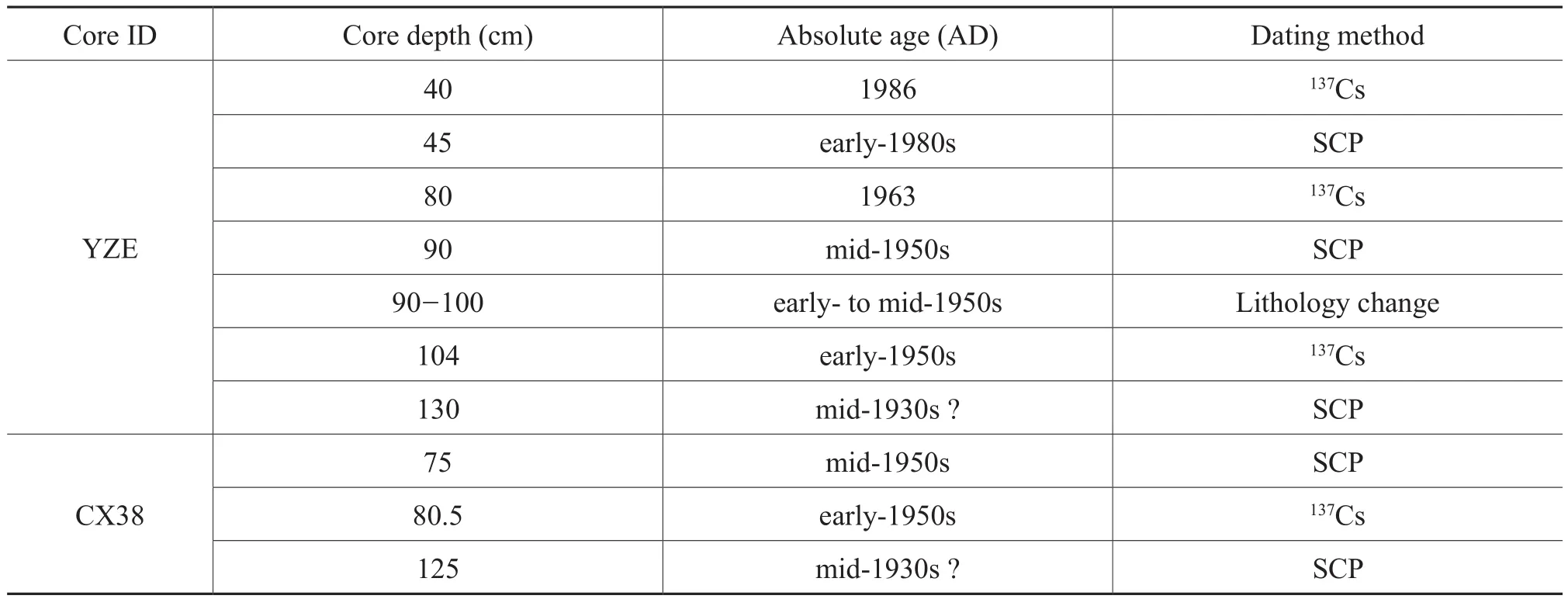
Table 1 Absolute ages derived by lithological changes and distributions of 137Cs and SCPs
5.1.4Validation of independent dating methods
The above absolute ages determined by independent methods including lithology change,137Cs and SCP profiles demonstrate good agreement with each other, especially for YZE (Table 1).From a core depth of 104 cm to a depth of 80 cm of YZE, ages from the early-1950s to year 1963 were inferred in order by different dating methods.Ages by SCP and137Cs are also in a reasonable sequence at a core depth of 40-45 cm,i.e., the early-1980s at 45 cm and year 1986 at 40 cm.In CX38, the137Cs age of the early-1950s at 80.5 cm can also be validated by the SCP age of mid-1950s at 75 cm (Table 1).Therefore, we suggest that the absolute ages inferred by lithology change,137Cs and SCP profiles are reliable.
5.2 Sedimentation rates determined by 210Pb profile and the limitations
We suggest that a mean sedimentation rate for YZE is impossible to establish from the excess210Pb profile because of its uniform pattern in the upper 100 cm section(Figure 5).Reasons could include the grain size effect(Kirchner and Ehlers, 1998),i.e., the higher sand content in the upper section.Sediments could also be eroded from the North Channel and redeposited at the core location(Chenet al., 1988), such as at 90-100 cm, thus containing a lower concentration of210Pb.The lithology is more homogeneous below 100 cm (Figure 3), and a mean sedimentation rate of 1.89 cm/yr can be obtained.Such a result is closer to, but still higher than the sedimentation rate of about 1.73 cm/yr which is calculated by the absolute ages from SCP and137Cs, supposing the SCP age at 130 cm is mid-1930s (Table 1).We thus suggest that the disturbed210Pb profile could lead to an overestimation of the sedimentation rate.
A mean sedimentation rate of 2.11 cm/yr is obtained by the CIC model when using the whole excess210Pb profile of CX38 (Figure 5).This sedimentation rate agrees roughly with the one inferred by137Cs and the SCP profiles, which is ~2 cm/yr as calculated from mid-1950s at~75 cm and early-1950s at 80.5 cm (Table 1).If there is no absolute age from the SCP profiles, the sedimentation rate from210Pb is unable to be validated by137Cs in this core,because only one absolute age is obtained by137Cs and the sediments lost from the top of the core during sampling is unknown.
5.3 Advantages and limitations of the SCP profiles for dating recent sediments
Previous studies of SCP in lake sediments demonstrate that the start of the SCP record in the middle Yangtze is around 1950 thus being earlier than 1940 in Taihu Lake on the Yangtze Delta plain (Figure 2).SCPs were detected, although very few in number, in the bottom samples of both cores in the present study (Figures 4, 5), where ages must be much older than 1950 according to the chronologies discussed above.The first thermal power station started in 1882 in Shanghai and the history of the annual thermal power output in Shanghai indicates more than 50 years of low levels of fossil-fuel combustion before the exponential increase following the mid-1950s (Figure 2).We thus suggest that SCPs in YZE and CX38 are mainly from local sources rather than the riverine discharge from the drainage basin, and that the change of SCP concentration in the sediments off the Yangtze River mouth directly reflects the economic and technical development along the Yangtze Delta coast, especially the megacities of Shanghai, Nanjing, Ningbo,etc.Because of the large amount of SCPs produced by local sources, the main features of the SCP profiles can be less influenced by counting errors,sediment mixing and resuspension.Although SCP concentrations in CX38 are obviously lower than that in YZE,the profile features are still enough to indicate an age of mid-1950s.These advantages of the SCP profiles will be of great help in dating sediments when the137Cs activities of 1950-1963 have decayed in the future decades.
Besides, SCP distributions in YZE and CX38 demonstrate that they are not influenced by sediment grain size as strongly as fallout radionuclides.Although the sediment is remarkably coarser in the upper section of YZE, the SCP concentration still increases exponentially upwards and is much higher than that in CX38 where mud dominates (Figure 5).Reasons could be that only SCPs with a diameter>10 μm were counted during the identification in addition to the significant increasing amount of SCP emission with the rapid development of the Yangtze coast.Experiments by Wik and Renberg (1991)revealed that there are large variations between individual particles for the settlement of SCPs in water.Some settle rapidly, some very slowly,while others, apparently with many internal airpockets,float on the water surface.We suggest that more coarse SCPs were deposited at the site of YZE since it is closer to the sources (Vuki?et al., 2006).This is supported by our randomly located photographs which show more big SCPs with a diameter >30 μm in YZE than in CX38 where there are more SCPs <20 μm (Figure 4a).
However, the SCP concentration could be diluted by the rapid deposition as suggested by its big fluctuation in the upper section of YZE (Figure 5).YZE is located in the North Channel offshore (Figure 1b), a site where the sedimentation rate is directly influenced by the amount of freshwater and sediment discharge from the North Channel (Chenet al., 1985; 1999).We have inferredc.10 cm deposition at 90-100 cm during the severe floods of the early-1950s according to the137Cs and210Pb distribution(Figure 5).There are also other big floods that occurred frequently during the last half of the 20thcentury such as 1971, 1991, 1996, 1998,etc.(Leunget al., 1999; Yuet al., 2009), which could have also caused events of rapid deposition at the core site of YZE.Further, the amount of freshwater and sediment discharge changed frequently because of the migration of the main waterway between the North and South Channel (Chenet al., 1985).Thus the sedimentation rate could not be uniform at the YZE core site and the SCP concentration declined significantly,such as at 20-30 cm (Figure 5), during the events of rapid deposition.The sedimentation rate could be more uniform at core site CX38 where deposition is mainly controlled by the longshore current (Chenet al., 1988; Liuet al., 2006),and thus the exponential increase of SCP concentration is more regular (Figure 5).
6 Conclusions
In this study we examined lithological changes, measured210Pb and137Cs activities, and identified SCP distributions in two short cores, YZE and CX38, from the Yangtze River mouth and the adjacent inner continental shelf of the East China Sea.Several conclusions can be drawn:
The lithology change and distribution of137Cs and SCPs produced absolute ages which were in a reasonable sequence and validated by each other for the recent sediments of YZE and CX38.The210Pb profiles are obviously disturbed by grain size effects or hydrodynamics especially in the upper section of YZE.The210Pb-derived mean sedimentation rate is roughly validated by137Cs and SCPs for CX38 where a near-exponential change of excess210Pb occurs.
The SCP profiles, taking advantage of significant changes in concentration following from economic development and less influenced by sediment grain size, could be a useful dating method for recent Yangtze offshore sediments.
Acknowledgements
The authors are grateful to Dr.B.Finlayson for correcting the language and grammar.This study is supported by the open funding of the Key Laboratory of Marine Hydrocarbon Resources and Environmental Geology, Ministry of Land and Resources, China (Grant No.MRE201001)and the Specialized Research Fund for the Doctoral Program of Higher Education of China (Grant No.20090076120019).The authors are also grateful for the project “high turbidity estuary and land-sea interaction” awarded by the Science Fund for Creative Research Groups of the National Natural Science Foundation of China (Grant No.40721004)for providing the two gravity cores.
Beardsley, R.C., Limeburner, R., Yu, H., Cannon, G.A., 1985.Discharge of the Changjiang (Yangtze River)into the East China Sea.Continental Shelf Research, 4: 57-76.
Boyle, J.F., Rose, N.L., Bennion, H., Yang, H., Appleby, P.G., 1999.Environmental impacts in the Jianghan Plain: Evidence from lake sediments.Water, Air, and Soil Pollution, 112: 21-40.
Changjiang Water Conservancy Commission, 1875-1990.Annual Report of Changjiang Water and Sediment.Unpublished report(in Chinese).
Chanton, J.P., Martens, C.S., Kipphut, G.W., 1983.Lead-210 sediment geochronology in a changing coastal environment.Geochimica et Cosmochimica Acta, 47: 1791-1804.
Chen, J.Y., Li, D.J., Chen, B.L., Hu, F.X., Zhu, H.F., Liu, C.Z.,1999.The processes of dynamic sedimentation in the Changjiang Estuary.Journal of Sea Research, 41: 129-140.
Chen, J.Y., Shen, H.T., Yun, C.X., 1988.Dynamic Processes and Morphological Evolution of Changjiang Estuary.Shanghai:Shanghai Science and Technology Press, 453 (in Chinese).
Chen, J.Y., Zhu, H.F., Dong, Y.F., Sun, J.M., 1985.Development of the Changjiang estuary and its submerged delta.Continental Shelf Research, 4: 47-56.
Cundy, A.B., Croudace, I.W., 1995.Physical and chemical associations of radionuclides and trace metals in estuarine sediments:An example from Poole Harbour, southern England.Journal of Environmental Radioactivity, 29: 191-211.
DeMaster, D.J., McKee, B.A., Nittrouer, C.A., Qian, J., Cheng,G., 1985.Rates of sediment accumulation and particle reworking based on radiochemical measurements from continental shelf deposits in the East China Sea.Continental Shelf Research, 4:143-158.
Kirchner, G., 2011.210Pb as a tool for establishing sediment chronologies: Examples of potentials and limitations of conventional dating models.Journal of Environmental Radioactivity, 102:490-494.
Kirchner, G., Ehlers, H., 1998.Sediment geochronology in changing coastal environments: Potentials and limitations of the137Cs and210Pb methods.Journal of Coastal Research, 14: 483-492.
Koide, M., Soutar, A., Goldberg, E.D., 1972.Marine geochronology with210Pb.Earth and Planetary Science Letters, 14: 442-446.
Leung, L.R., Ghan, S.J., Zhao, Z.C., Luo, Y., Wang, W.C., Wei, H.L., 1999.Intercomparison of regional climate simulations of the 1999 summer monsoon in eastern Asia.Journal of Geophysical Research, 104: 6425-6454.
Lewis, R.C., Coale, K.H., Edwards, B.D., Marot, M., Douglas, J.N., Burton, E.J., 2002.Accumulation rate and mixing of shelf sediments in the Monterey Bay National Marine Sanctuary.Marine Geology, 181: 157-169.
Liu, J.P., Li, A.C., Xu, K.H., Velozzi, D.M., Yang, Z.S., Milliman,D.D., DeMaster, D.J., 2006.Sedimentary features of the Yangtze River-derived along-shelf clinoform deposit in the East China Sea.Continental Shelf Research, 26: 2141-2156.
Marshall, W.A., Gehrels, W.R., Garnett, M.H., Freeman, S.P.H.T.,Maden, C., Xu, S., 2007.The use of ‘bomb spike’ calibration and high-precision AMS14C analyses to date saltmarsh sediments deposited during the past three centuries.Quaternary Research, 68:325-337.
Milliman, J.D., Shen, H.T., Yang, Z.S., Meade, R.H., 1985.Transport and deposition of river sediment in the Changjiang Estuary and adjacent continental shelf.Continental Shelf Research, 4:37-45.
Renberg, I., Wik, M., 1985.Carbonaceous particles in lake sediments— Pollutants from fossil fuel combustion.Ambio, 14: 161-163.
Rose, N.L., 1994.A note on further refinements to a procedure for the extraction of carbonaceous fly-ash particles from sediments.Journal of Paleolimnology, 11: 201-204.
Rose, N.L., 2001.Fly-ash particles.In: Last, W.M., Smol, J.P.,(eds).Tracking Environmental Change Using Lake Sediments.Volume 2: Physical and Geochemical Methods.Dordrecht: Kluwer Academic Publishers, 319-349.
Rose, N.L., 2008.Quality control in the analysis of lake sediments for spheroidal carbonaceous particles.Limnology and Oceanography, Methods 6: 172-179.
Rose, N.L., Appleby, P.G., 2005.Regional applications of lake sediment dating by spheroidal carbonaceous particle analysis I:United Kingdom.Journal of Paleolimnology, 34: 349-361.
Rose, N.L., Boyle, J.F., Du, Y., Yi, C., Dai, X., Appleby, P.G., Bennion, H., Cai, S., Yu, L., 2004.Sedimentary evidence for changes in the pollution status of Taihu in the Jiangsu region of eastern China.Journal of Paleolimnology, 32: 41-51.
Rose, N.L., Harlock, S., Appleby, P.G., Battarbee, R.W., 1995.Dating of recent lake sediments in the United Kingdom and Ireland using spheroidal carbonaceous particle (SCP)concentration profiles.The Holocene, 5: 328-335.
Ruiz-Fernández, A.C., Hillaire-Marcel, C., 2009.210Pb-derived ages for the reconstruction of terrestrial contaminant history into the Mexican Pacific coast: Potential and limitations.Marine Pollution Bulletin, 59: 134-145.
Smith, J.N., 2001.Why should we believe210Pb sediment geochronologies? Journal of Environmental Radioactivity, 55: 121-123.
Su, C.C., Huh, C.A., 2002.210Pb,137Cs and239,240Pu in East China Sea sediments: Sources, pathways and budgets of sediments and radionuclides.Marine Geology, 183: 163-178.
Vaalgamaa, S., Korhola, A., 2004.Searching for order in chaos: A sediment stratigraphical study of a multiple-impacted bay of the Baltic Sea.Estuarine, Coastal and Shelf Science, 59: 319-332.
Vuki?, J., Fott, J., Petrusek, A., ?anda, R., 2006.What can size distribution of spheroidal carbonaceous particles reveal about their source? Atmospheric Environment, 40: 3527-3535.
Wan, G.J., Chen, J.A., Wu, F.C., Xu, S.Q., Bai, Z.G., Wan, E.Y.,Wang, C.S., Huang, R.G., Yeager, Y.M., Santschi, P.H., 2005.Coupling between210Pbexand organic matter in sediments of a nutrient-rich lake: An example from Lake Chenghai, China.Chemical Geology, 224: 223-236.
Wei, T., Chen, Z., Duan, L., Gu, J., Saito, Y., Zhang, W., Wang, Y.,Kanai, Y., 2007.Sedimentation rates in relation to sedimentary processes of the Yangtze Estuary, China.Estuarine, Coastal and Shelf Science, 71: 37-46.
Wik, M., Renberg, I., 1991.Spheroidal carbonaceous particles as a marker for recent sediment distribution.Hydrobiologia, 214:85-90.
Wu, Y., Wang, S., Xia, W., Liu, J., 2005.Dating recent lake sediments using spheroidal carbonaceous particle (SCP).Chinese Science Bulletin, 50: 1016-1020.
Yu, F., Chen, Z., Ren, X., Yang, G., 2009.Analysis of historical floods on the Yangtze River, China: Characteristics and explanations.Geomorphology, 113: 210-216.
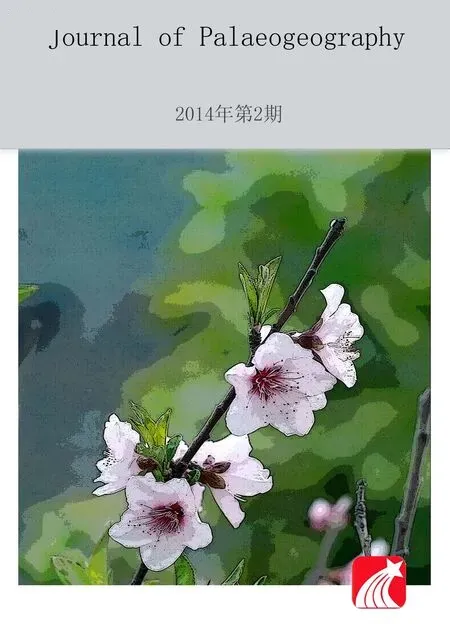 Journal of Palaeogeography2014年2期
Journal of Palaeogeography2014年2期
- Journal of Palaeogeography的其它文章
- Palinspastic reconstruction and geological evolution of Permian residual marine basins bordering China and Mongolia
- Callovian-Oxfordian hecticoceratins from western India: Their biostratigraphic and palaeobiogeographic implications
- Restrictions to the application of ‘diagnostic’criteria for recognizing ancient seismites
- Jurassic sedimentary evolution of southern Junggar Basin: Implication for palaeoclimate changes in northern Xinjiang Uygur Autonomous Region, China
- Palaeoenvironmental and biostratigraphic implications of microbial mat-related structures:Examples from the modern Gulf of Cambay and the Precambrian Vindhyan Basin, India
- Peritidal carbonate cycles induced by carbonate productivity variations: A conceptual model for an isolated Early Triassic greenhouse platform in South China
